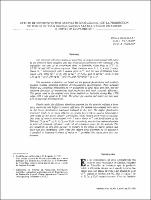| dc.description.abstract | The economic efficiency and price sensitivity of cassava intercropped with maize in six different plant densities and two fertilization treatments were evaluated. This evaluation was part of an experiment done in hirrialba, Costa Rica, at 9°.5.3' N, 83°39' IV and 602 in above sea level. Plant densities were 0, 1, 3, 4 and 5 maize plants in intercropped with 1 cassava plant m-2, and the two fertilization treatments were: 90kg ha-1 of N, 200 kg ha-1 of P205, and 75 kg ha-1 of K20, and 120 kg ha-1 of N, 200 kg ha-1 of P2 0s, and 150 kg ha-1 of K20.
The economic evaluation was based on the general factor-factor and product-product models, assuming different decision-making circumstances. They included simple and combined restrictions on the availability of land, labor and cash, and the objective functions of maximizing food production and total economic efficiency. The prices used in the analysis were those available in Thrrialba during May 1978 when US$ 1 was equal to 8.60. The prices for cassava and maize per ton were $7.5.50 and $241.90 respectively.
Results under the different situations assumed for the analysis indicate a lower price sensitivity and higher economic efficiency for cassava intercropped with maize at the lower fertilization treatment included in the test. The higher fertilization treatment tends to be more efficient in cassava monocrop or cassava intercropped with maize at the lowest density, particularly when cassava price tends to increase. One plant of cassava intercropped with 2 maize plants in and fertilization of 90, 200 and 75 kg ha-1 of N, P2O5 and K2 0 respectively, was the best evaluated option in terms of economic efficiency under all circumstances given for the analysis. The low sensitivity of this crop mixture to changes in the prices of maize, cassava and labor was also remarkable. Only when the cassava price decreases by 61 percent is it justified to intercrop 4 plants of maize m-2, provided the maize price does not decrease. | es_ES |


